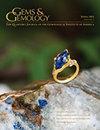A Quantitative Description of the Causes of Color in Corundum
IF 1.6
3区 地球科学
Q2 MINERALOGY
引用次数: 19
Abstract
GEMS & GEMOLOGY SPRING 2020 Gemstones are valued for their beauty, rarity, and durability, and what typically captures our attention is their magnificent array of colors. Corundum exhibits an extremely wide range of colors in nature (figure 1). From pigeon’s blood red ruby to cornflower blue and lemon yellow sapphire, nearly every color is represented. The only corundum color not represented in nature is a saturated intense emerald green. However, less intense olive green to teal green stones are often found in basalt-hosted corundum deposits. Corundum’s broad range of colors is related to its detailed chemistry. Some minerals possess inherent color because the chromophore is one of the basic chemical components of its makeup. Such stones are termed idiochromatic, meaning self-colored. For example, turquoise, whose chemical formula is CuAl6(PO4)4(OH)8•4H2O, is colored by copper, a primary component of its structure. Other minerals such as corundum are, when very pure, completely colorless. In fact, pure corundum, with the chemical formula Al2O3, is absolutely transparent from the deep ultraviolet region into the infrared. Such minerals are termed allochromatic. Their colors in nature are caused by minor impurities, referred to as trace elements, or other point defects in the crystal lattice that have been incorporated during growth or later equilibration in nature. The causes of color in corundum are many and have been primarily addressed in a non-quantitative way for many years (see, for example, Fritsch and Rossman, 1987, 1988; Häger, 2001; Emmett et al., 2003). Trace elements themselves can be the direct cause of color. Cr3+, for example, creates pink and red coloration in corundum. Trace elements can also interact with each other, creating a new chromophore. The Fe2+-Ti4+ pair is such an example, strongly absorbing in the yellow and red regions of the spectrum and thus creating magnificent blue sapphires. When beryllium-diffused corundum entered the marketplace, we were surprised by the wide range of colors that were produced, seemingly by a single element (Emmett et al., 2003). Measurements of the beryllium levels showed that the concentrations were generally from a few to a few tens of parts per million atomic (ppma), yet the colors produced were often intense. For comparison, red coloration in corundum requires several hundred to a few thousand ppma of Cr3+, a concentration at least two orders of magnitude greater than Be2+, to produce strong color. Our studies of the beryllium-diffused stones (Emmett et al., 2003) demonstrated that the Be2+ ion itself was not the cause of color. However, replacing a trivalent aluminum ion with a divalent beryllium ion required the creation of a trapped hole (h•) for A QUANTITATIVE DESCRIPTION OF THE CAUSES OF COLOR IN CORUNDUM刚玉变色原因的定量描述
2020年春季宝石与宝石学宝石因其美丽、稀有和耐用而备受重视,通常吸引我们注意的是它们华丽的颜色。刚玉在自然界中表现出极其广泛的颜色(图1)。从鸽子血红色的红宝石到矢车菊蓝色和柠檬黄色的蓝宝石,几乎每种颜色都有代表性。唯一没有在自然界中表现出来的刚玉颜色是饱和的强烈的翠绿色。然而,在玄武岩主持的刚玉矿床中经常发现强度较低的橄榄绿到蓝绿色的石头。刚玉广泛的颜色与其精细的化学性质有关。一些矿物具有固有的颜色,因为发色团是其组成的基本化学成分之一。这种石头被称为“自着色”,意思是自着色。例如,绿松石,其化学式为CuAl6(PO4)4(OH)8•4H2O,由铜着色,铜是其结构的主要成分。刚玉等其他矿物在非常纯净时是完全无色的。事实上,化学式为Al2O3的纯刚玉从深紫外区域到红外区域都是绝对透明的。这种矿物被称为异色矿物。它们在自然界中的颜色是由晶格中的微量杂质(称为微量元素)或其他点缺陷引起的,这些杂质在生长或后来的自然界平衡过程中被引入。刚玉变色的原因有很多,多年来主要以非定量的方式解决(例如,见Fritsch和Rossman,19871988;Häger,2001年;Emmett等人,2003年)。微量元素本身可能是造成颜色的直接原因。例如,Cr3+在刚玉中产生粉红色和红色。微量元素也可以相互作用,产生一个新的发色团。Fe2+-Ti4+对就是这样一个例子,它强烈吸收光谱的黄色和红色区域,从而产生了壮观的蓝色蓝宝石。当铍扩散刚玉进入市场时,我们对其产生的广泛颜色感到惊讶,似乎是由单一元素产生的(Emmett等人,2003)。铍含量的测量表明,铍的浓度通常为百万分之几到几十,但产生的颜色往往很强烈。相比之下,刚玉中的红色着色需要几百到几千ppma的Cr3+,其浓度至少比Be2+高两个数量级,才能产生强烈的颜色。我们对铍扩散石头的研究(Emmett等人,2003)表明,Be2+离子本身并不是颜色的原因。然而,用二价铍离子代替三价铝离子需要产生一个捕获孔(h•)来定量描述刚玉颜色的原因
本文章由计算机程序翻译,如有差异,请以英文原文为准。
求助全文
约1分钟内获得全文
求助全文
来源期刊

Gems & Gemology
地学-矿物学
CiteScore
2.90
自引率
19.20%
发文量
10
期刊介绍:
G&G publishes original articles on gem materials and research in gemology and related fields. Manuscript topics include, but are not limited to:
Laboratory or field research;
Comprehensive reviews of important topics in the field;
Synthetics, imitations, and treatments;
Trade issues;
Recent discoveries or developments in gemology and related fields (e.g., new instruments or identification techniques, gem minerals for the collector, and lapidary techniques);
Descriptions of notable gem materials and localities;
Jewelry manufacturing arts, historical jewelry, and museum exhibits.
 求助内容:
求助内容: 应助结果提醒方式:
应助结果提醒方式:


